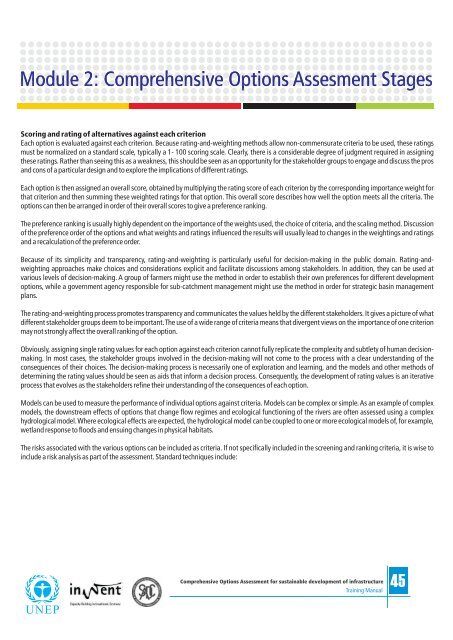Comprehensive Option Assesment - UNEP
Comprehensive Option Assesment - UNEP
Comprehensive Option Assesment - UNEP
Create successful ePaper yourself
Turn your PDF publications into a flip-book with our unique Google optimized e-Paper software.
Module 2: <strong>Comprehensive</strong> <strong>Option</strong>s <strong>Assesment</strong> Stages<br />
Scoring and rating of alternatives against each criterion<br />
Each option is evaluated against each criterion. Because rating-and-weighting methods allow non-commensurate criteria to be used, these ratings<br />
must be normalized on a standard scale, typically a 1- 100 scoring scale. Clearly, there is a considerable degree of judgment required in assigning<br />
these ratings. Rather than seeing this as a weakness, this should be seen as an opportunity for the stakeholder groups to engage and discuss the pros<br />
and cons of a particular design and to explore the implications of different ratings.<br />
Each option is then assigned an overall score, obtained by multiplying the rating score of each criterion by the corresponding importance weight for<br />
that criterion and then summing these weighted ratings for that option. This overall score describes how well the option meets all the criteria. The<br />
options can then be arranged in order of their overall scores to give a preference ranking.<br />
The preference ranking is usually highly dependent on the importance of the weights used, the choice of criteria, and the scaling method. Discussion<br />
of the preference order of the options and what weights and ratings influenced the results will usually lead to changes in the weightings and ratings<br />
and a recalculation of the preference order.<br />
Because of its simplicity and transparency, rating-and-weighting is particularly useful for decision-making in the public domain. Rating-andweighting<br />
approaches make choices and considerations explicit and facilitate discussions among stakeholders. In addition, they can be used at<br />
various levels of decision-making. A group of farmers might use the method in order to establish their own preferences for different development<br />
options, while a government agency responsible for sub-catchment management might use the method in order for strategic basin management<br />
plans.<br />
The rating-and-weighting process promotes transparency and communicates the values held by the different stakeholders. It gives a picture of what<br />
different stakeholder groups deem to be important. The use of a wide range of criteria means that divergent views on the importance of one criterion<br />
may not strongly affect the overall ranking of the option.<br />
Obviously, assigning single rating values for each option against each criterion cannot fully replicate the complexity and subtlety of human decisionmaking.<br />
In most cases, the stakeholder groups involved in the decision-making will not come to the process with a clear understanding of the<br />
consequences of their choices. The decision-making process is necessarily one of exploration and learning, and the models and other methods of<br />
determining the rating values should be seen as aids that inform a decision process. Consequently, the development of rating values is an iterative<br />
process that evolves as the stakeholders refine their understanding of the consequences of each option.<br />
Models can be used to measure the performance of individual options against criteria. Models can be complex or simple. As an example of complex<br />
models, the downstream effects of options that change flow regimes and ecological functioning of the rivers are often assessed using a complex<br />
hydrological model. Where ecological effects are expected, the hydrological model can be coupled to one or more ecological models of, for example,<br />
wetland response to floods and ensuing changes in physical habitats.<br />
The risks associated with the various options can be included as criteria. If not specifically included in the screening and ranking criteria, it is wise to<br />
include a risk analysis as part of the assessment. Standard techniques include:<br />
<strong>Comprehensive</strong> <strong>Option</strong>s Assessment for sustainable development of infrastructure<br />
Training Manual<br />
45
















